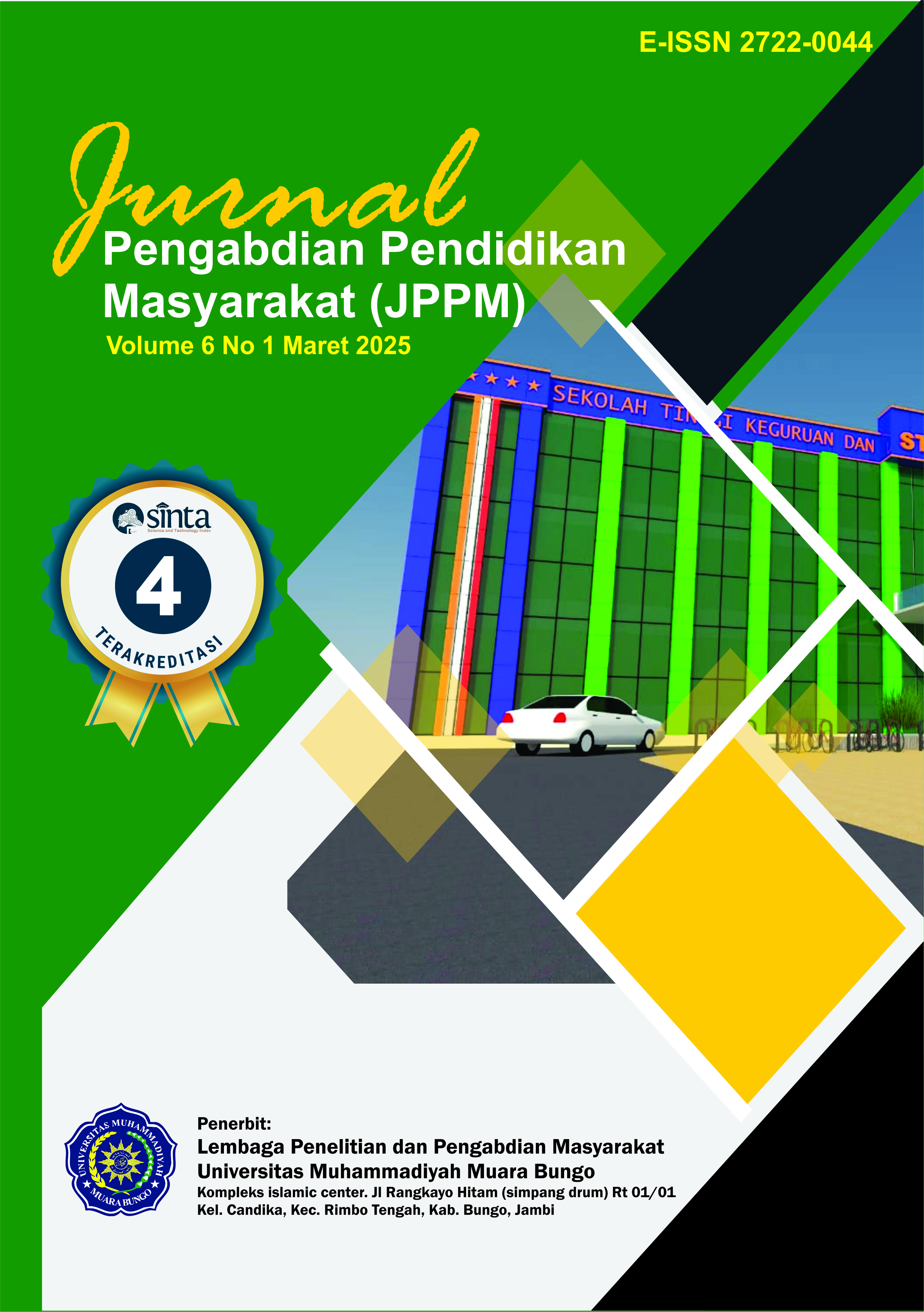DESIGN AND DEVELOPMENT AND UTILIZATION OF LEARNING TECHNOLOGY IN BASIC EDUCATION
Abstract
The purpose of this service is to carry out the Tri Dharma of Higher Education activities, one of which is community service activities, providing education to educators in increasing knowledge about developing learning technology designs, and as a consideration for carrying out sustainable community service activities. The role of learning technology in learning design is complex and varied. Overall, learning technology plays a role as the main driver in designing learning that is more adaptive, interactive and effective. Although, technology has the potential to enrich learning experiences, it also raises concerns regarding the digital divide, teacher capabilities, and curriculum alignment. A balanced approach to instructional design, which combines the power of technology with the wisdom of traditional teaching methods, is essential to achieving effective learning outcomes. The use of learning media to be effective requires the application of an appropriate learning approach. The solution to partner problems, namely one approach that is suitable for the society 5.0 era, is the STEM approach. The basis for implementing community service activities. The results of this service are the success of the target number of service participants, achievement of service goals, achievement of planned material targets, participants' ability to master the material, participants' ability to practice the technology that has been delivered by the service, collaboration between the campus and partners, achievement in improving quality digital-based assessment, achievement in increasing understanding of digital-based media innovation.
References
Azimjanova, M. T. (2022). Distance Learning System as a Means of Information and Communication Technologies in the Educational Process. European Journal of Innovation in Nonformal Education ( EJINE ), 2(6), 85–87.
Boentolo, F., Manu, C.-C. C. R., Saragih, O. G., & Zalukhu, S. (2024). Peran Guru Memanfaatkan Ai Dalam Membangun Generasi Unggul Menuju Indonesia Emas 2045. Aletheia Christian Educators Journal, 5(1), 42–48. https://doi.org/10.9744/aletheia.5.1.42-48
Chandra, E., Setiawan, M. N., Sulystiawati, D., & Warjoyo, J. G. (2025). Peningkatan Kompetensi Teknologi Digital dalam Pendidikan Seni di SD Sinar Dharma Jakarta Barat. 7(2), 255–262. https://doi.org/10.31334/jks.v7i2.4396
Dwijaya, R. A., & Rigianti, H. A. (2024). Peran Guru dalam Menumbuhkan Karakter Peduli Lingkungan Pada Siswa di Sekolah Dasar. NUSRA : Jurnal Penelitian Dan Ilmu Pendidikan, 5(2), 509–522. https://doi.org/10.55681/nusra.v5i2.2524
Hernández-Campos, E., Jaimez-González, C. R., & García-Mendoza, B. (2020). Interactive mobile applications to support the teaching of reading and writing of Spanish for children in primary education. International Journal of Interactive Mobile Technologies, 14(14), 64–79. https://doi.org/10.3991/ijim.v14i14.14925
Noptario, N., Rizki, N., Nur’aini, N., & Ningrum, E. C. (2024). Peran Guru dalam Kurikulum Merdeka: Upaya Penguatan Keterampilan Abad 21 Siswa di Sekolah Dasar. Ideguru: Jurnal Karya Ilmiah Guru, 9(2), 656–663.https://doi.org/10.51169/ideguru.v9i2.813
Pujiastuti, A., Nurhidayah, S. A., & Ridhasyah, R. (2025). Workshop Penggunaan Quizizz Dalam Meningkatkan Pembelajaran Digital Dan Interaktif. 4(1), 43–48. https://doi.org/10.37905/ljpmt.v4i1.29
| Keywords | : |
Keywords:
Design, Development, Utilization, Technology, Education. Desain., Pengembangan, Pemanfaatan Teknologi Pendidikan
|
| Galleys | : | |
| Published | : |
2025-03-05
|
| How to Cite | : |
Nurmawati, F., Prihatmojo, A., Nailil Hikmah, A., & Rahma Kamila, A. (2025). DESIGN AND DEVELOPMENT AND UTILIZATION OF LEARNING TECHNOLOGY IN BASIC EDUCATION. Jurnal Pengabdian Pendidikan Masyarakat (JPPM), 6(1), 116–123. https://doi.org/10.52060/jppm.v6i1.2807
|
| Issue | : |



.png)


33.png)



_SCCC.png)

